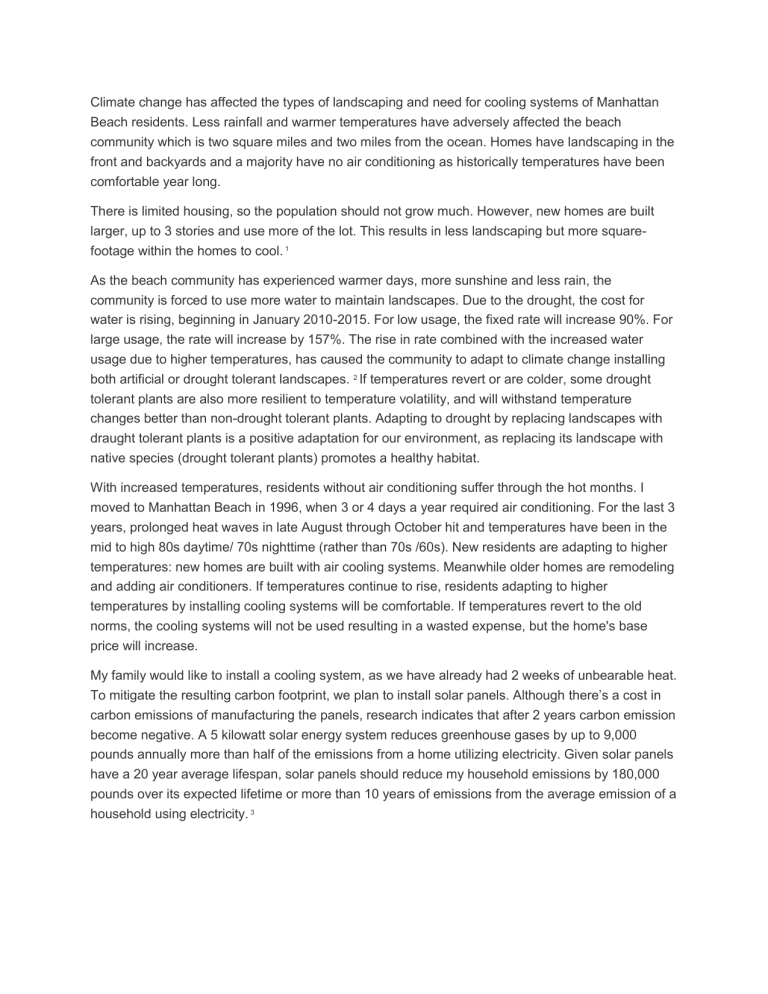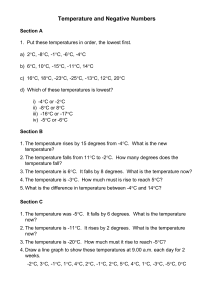Climate Change Impact on Manhattan Beach Landscaping & Cooling
advertisement

Climate change has affected the types of landscaping and need for cooling systems of Manhattan Beach residents. Less rainfall and warmer temperatures have adversely affected the beach community which is two square miles and two miles from the ocean. Homes have landscaping in the front and backyards and a majority have no air conditioning as historically temperatures have been comfortable year long. There is limited housing, so the population should not grow much. However, new homes are built larger, up to 3 stories and use more of the lot. This results in less landscaping but more squarefootage within the homes to cool. 1 As the beach community has experienced warmer days, more sunshine and less rain, the community is forced to use more water to maintain landscapes. Due to the drought, the cost for water is rising, beginning in January 2010-2015. For low usage, the fixed rate will increase 90%. For large usage, the rate will increase by 157%. The rise in rate combined with the increased water usage due to higher temperatures, has caused the community to adapt to climate change installing both artificial or drought tolerant landscapes. 2 If temperatures revert or are colder, some drought tolerant plants are also more resilient to temperature volatility, and will withstand temperature changes better than non-drought tolerant plants. Adapting to drought by replacing landscapes with draught tolerant plants is a positive adaptation for our environment, as replacing its landscape with native species (drought tolerant plants) promotes a healthy habitat. With increased temperatures, residents without air conditioning suffer through the hot months. I moved to Manhattan Beach in 1996, when 3 or 4 days a year required air conditioning. For the last 3 years, prolonged heat waves in late August through October hit and temperatures have been in the mid to high 80s daytime/ 70s nighttime (rather than 70s /60s). New residents are adapting to higher temperatures: new homes are built with air cooling systems. Meanwhile older homes are remodeling and adding air conditioners. If temperatures continue to rise, residents adapting to higher temperatures by installing cooling systems will be comfortable. If temperatures revert to the old norms, the cooling systems will not be used resulting in a wasted expense, but the home's base price will increase. My family would like to install a cooling system, as we have already had 2 weeks of unbearable heat. To mitigate the resulting carbon footprint, we plan to install solar panels. Although there’s a cost in carbon emissions of manufacturing the panels, research indicates that after 2 years carbon emission become negative. A 5 kilowatt solar energy system reduces greenhouse gases by up to 9,000 pounds annually more than half of the emissions from a home utilizing electricity. Given solar panels have a 20 year average lifespan, solar panels should reduce my household emissions by 180,000 pounds over its expected lifetime or more than 10 years of emissions from the average emission of a household using electricity. 3





